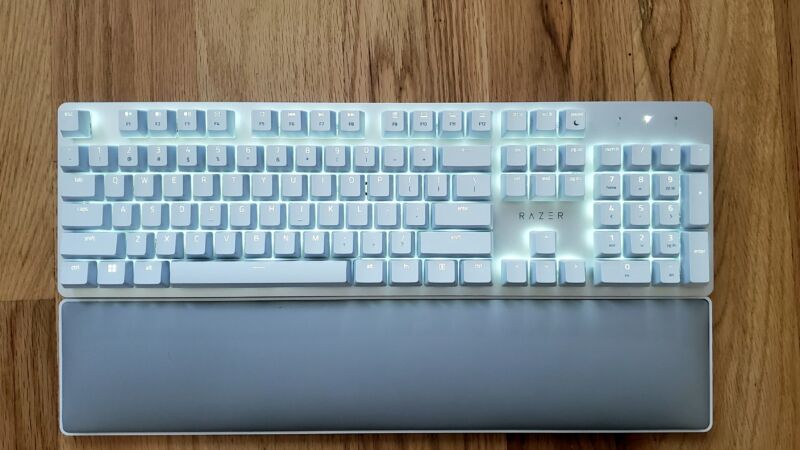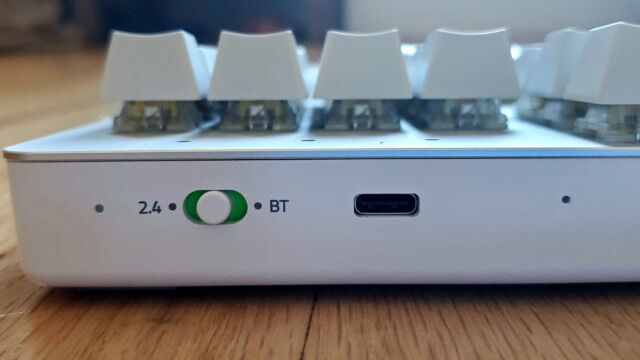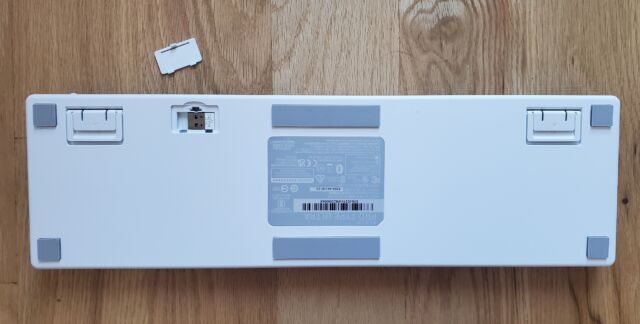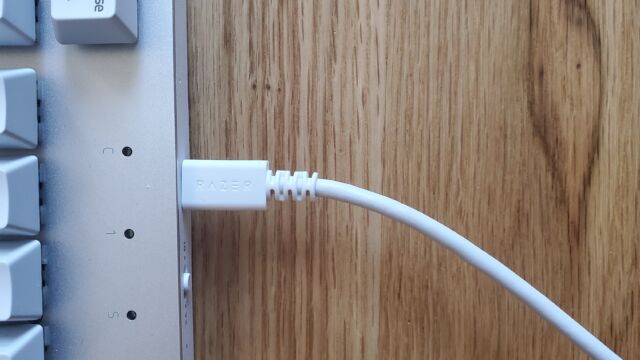
Razer Pro Type Ultra
It’s nearly 2022, yet it’s still hard to find a good wireless mechanical keyboard. There are options, sure, but if you’re after a numpad, a decent price, or different color options, the pool gets small. But an unlikely ally has emerged in the battle for more wireless mechanical options: pricey peripheral-maker Razer, which is now entering the productivity space with fewer RGB lights or snake logos.
The Razer Pro Type Ultra, announced this week for $160 and set to ship in Q4, can connect to three devices via Bluetooth (you switch between them using keyboard shortcuts). It also features a wireless dongle and a cable for wired connections, so it’s ready for today’s multi-device world. Razer’s Synapse software lets users reprogram the Pro Type Ultra’s buttons and even create macros to make work more efficient.
However, the Pro Type Ultra isn’t a solution for everyone. For one thing, it adds to the already high price of the original Razer Pro Type, which currently has an MSRP of $126 (though it’s sometimes cheaper). The new keyboard offers much better battery life, dampening foam for a quieter sound profile, and a wrist rest—at the cost of some extra cash.
And with only one type of linear switch available, fans of tactile and clicky keyboards are left out. Razer has focused on “quiet” to play up the productivity angle, but I’ve worked in offices filled with tech journalists before; no one holds back with their loud, clicky keyboards, and Razer shouldn’t either.
One keyboard wirelessly connected to four devices
For $160, you could pick up four cheap wired mechanical keyboards and connect them to four different devices. Or you could get the Pro Type Ultra and have it constantly paired to four devices, which you can toggle through as needed. If this feature doesn’t get you excited, then you might want to consider other options, because this is a big contributor to the Pro Type Ultra’s price tag.
| Specs at a glance: Razer Pro Type Ultra | |||
|---|---|---|---|
| Switches | Razer Yellow | ||
| Keycaps | Doubleshot ABS plastic | ||
| Connectivity Options | Bluetooth Low Energy, 2.4 GHz dongle, or USB-C to USB-A cable | ||
| Backlighting | White LEDs | ||
| Programmability | All keys except Windows and Fn | ||
| Size | 17.3×5.2×1.6 inches (439×131×40 mm) | ||
| Weight | 2.3 lbs (1038 g) with cable | ||
| Warranty | 2 years | ||
| Price (MSRP) | $160 | ||
| Other perks | Detachable USB-C to USB-A cable, detachable wrist rest | ||
I connected the Pro Type Ultra to my work laptop, my personal laptop, and a tablet via Bluetooth, and I left the dongle in a stationary PC. Toggling through each Bluetooth device worked easily. By hitting Fn and 1, 2, or 3, I could control a different machine in a heartbeat. (The three lights in the keyboard’s upper-left corner flash one, two, or three times to let you know which Bluetooth profile you’re using.)
Switching to the PC with the wireless dongle was even easier. A switch on the keyboard’s top edge lets you pick Bluetooth, 2.4 GHz (the dongle), or wired mode. Seeing these labels from a typical seated position required that I lean over awkwardly… or to memorize the switch positions.
Even when using a Bluetooth mouse alongside the Pro Type Ultra, there were no obvious lag issues. If you’re concerned, though, the dongle is supposed to offer less lag than the Bluetooth connection. It uses Razer’s HyperSpeed tech that the company also uses for its gaming peripherals, where lag is an even bigger no-no. (Note that If you have a supported Razer mouse, you can connect two devices to a single dongle and save a USB port.)

Dongle storage is critical for people like me who easily lose things. Thankfully, the Pro Type Ultra has a small dongle compartment on its underside. The plastic cover there isn’t too thick, so I’d be careful with it.

The cable, meanwhile, matches the keyboard in white. Although it’s chunky, the cable uses cheaper rubber rather than something braided.

Limited wireless competition
The Razer Pro Type Ultra is more expensive than most other productivity-focused mechanical wireless keyboards but more affordable than many gaming-focused ones.
For example, the Keychron K10 is notably cheaper (up to $104 MSRP as of writing) and still lets you connect to three devices via Bluetooth. But there’s no dongle.
The “non-Ultra” Razer Pro Type, mentioned above, has a $126 MSRP and can connect in all the ways the Ultra can. However, battery life is much shorter—up to about 84 hours with a Bluetooth connection, compared to the Ultra’s 214 hours.
If you’re sticking to better-known brands, you’ll get more options from the gaming side of the keyboard spectrum, but these options come at a cost. Razer’s BlackWidow V3 Pro has a $230 MSRP—recently, we’re seeing it go for $169-$180—and also lets you connect to multiple devices and use a dongle. It has media keys and a fancier wrist rest, too. You can get Logitech’s G915 Lightspeed for $200 or the G613 for an $80 MSRP (available for about $71 as of writing), but each only has one Bluetooth profile.
Logitech has some more wireless options that take multi-device control further by letting you drag and drop files across PCs via the company’s Flow feature, but none of those keyboards offers the greatness of true mechanical switches.
https://arstechnica.com/?p=1809648

